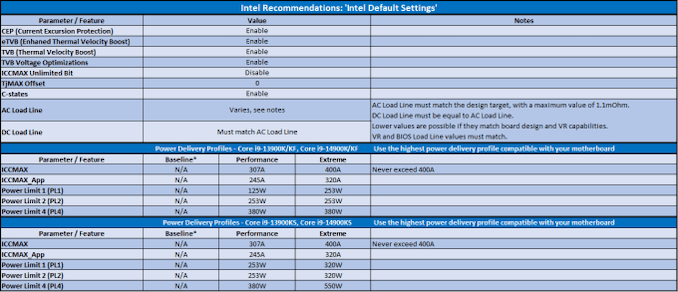Following our previous report on Intel’s directive to motherboard manufacturers to adhere to stock power settings for its 14th and 13th Generation Core processors, Intel has issued a supplementary statement. In response to Intel’s initial request, motherboard manufacturers hastily launched firmware updates introducing an ‘Intel Baseline’ profile, which they presumed would mitigate the reported instability issues.
However, Intel has expressed concerns regarding these Intel Baseline profiles, highlighting that they should not be mistaken for Intel’s own default specifications. Despite being named ‘Baseline’, these profiles suggest adherence to standard settings, but still allow room for manufacturers to apply their own interpretations of Multi-Core Enhancement (MCE), which has led to some confusion.
To provide clearer guidance, Intel shared this statement with us:
Intel has observed that several manufacturers have introduced BIOS options labeled ‘Intel Baseline Profile’. It is important to note that these are not equivalent to the ‘Intel Default Settings’ that were recommended to address the instability concerns with 13th and 14th gen K SKU processors.
The ‘Intel Baseline Profile’ BIOS settings seem to draw upon previous Intel guidelines regarding power delivery options for these processors, based on what the motherboards can handle.
Intel does not endorse using ‘baseline’ power delivery configurations on boards that are designed for higher capabilities.
Instead, Intel advises employing the ‘Intel Default Settings’, which comprise a mix of thermal and power delivery mechanisms, in addition to a selection of potential power delivery schemes suitable for the motherboard in question.
Customers are encouraged to apply the most robust power delivery profile that aligns with their motherboard’s design, as outlined below:

Click to Enlarge Intel’s Default Settings
Intel’s clarifications urge consumers to steer away from the Baseline Power Delivery profiles introduced by motherboard manufacturers through numerous firmware updates. Instead of these, Intel advocates for the use of Intel Default Settings, which align with the processor’s specifications as set by Intel to ensure the advertised clock speeds, without the risk of instability due to ‘over’ optimizations often seen in firmware updates.
Moreover, Intel Default Settings encompass a range of thermal and power specifications, including adjustments to voltage and frequency curves that match the motherboard’s capabilities and power delivery features, ensuring compatibility and reliability, particularly for K, KF, and KS SKUs of the 13th and 14th Generation Core series.
Highlighting the differences, Intel emphasizes the importance of restricting processor current to 400 A for both the 13th and 14th Gen, even under Extreme profiles, which contradicts the ‘unlimited’ power and current approach adopted by some for the sake of maximizing performance, a practice that can compromise stability and generate excessive heat during demanding tasks.
Intel also specifies that for maximum stability, the AC Load Line must comply with the processor’s design target, with a maximum of 1.1 mOhm, and the DC Load Line must be equal to the AC Load Line. Additionally, for stability under extreme profiles, Intel recommends activating CEP, eTVB, C-states, TVB, and TVB Voltage Optimizations.
Intel’s insistence on using stock ‘Default’ settings out of the box, until otherwise specified, echoes our understanding that while motherboard manufacturers are keen to demonstrate their products’ capabilities, a clearer communication path between Intel and its partners is crucial to resolving the ongoing instability issues.
Concluding, Intel advises against using vendor-supplied Baseline profiles, instead urging customers to implement the highest compatible power delivery profile according to their motherboard’s specifications and design. This stance from Intel indicates the complex nature of the ongoing discussions surrounding these instability issues, with further developments expected.